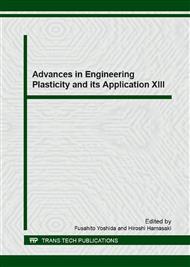p.305
p.311
p.316
p.322
p.328
p.334
p.339
p.345
p.351
Thermo-Elasto-Plastic Analysis of Pearlitic Transformation Plasticity under Combined Bending-Tensile Loading
Abstract:
In a previous study, we showed the anisotropy of plastic strain due to the pearlitic transformation and proposed a hydrostatic pressure-dependent constitutive equation to describe this phenomenon. In the present study, we assess the validity of this model using a bending-tensile loading system to experimentally and numerically analyze and characterize the pearlitic transformation plasticity. First, the maximum bending deflections due to the austenite-pearlite transformation were measured under different loadings and then transformation-plasticity coefficients were determined. Furthermore, as was done for bending-tensile loading tests, the pearlitic transformation plasticity was simulated using Abaqus Standard under the same austenitization and loading conditions as in experiments, and the calculated results for pearlitic-transformation plastic deformation are compared with the experimental results. The results show that the transformation plastic deflection due to the pearlitic transformation decreases with increasing applied tensile stress. In addition, this behavior can be described by a hydrostatic pressure-dependent model in large-deformation theory.
Info:
Periodical:
Pages:
328-333
Citation:
Online since:
December 2016
Authors:
Price:
Сopyright:
© 2017 Trans Tech Publications Ltd. All Rights Reserved
Share:
Citation:


